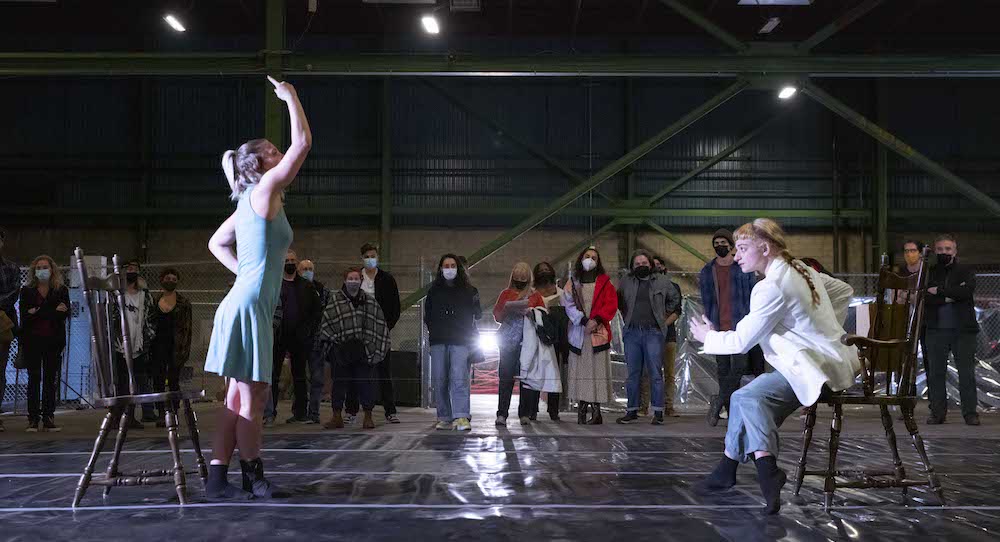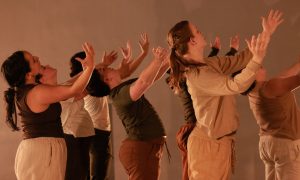Gardenship Art, Kearny, NJ.
December 10, 2021.
For those who crave the delights that a given art form is uniquely in a position to offer, mignolo dance’s Visitor Parking provides plenty of excellent choreography. The solos and group sections are filled with inventive, precisely rendered movement (much of it tailored to the demands of Movenglish®, a dance-language invented by Eriel and Charly Santagado that aspires to maintain a one-to-one correspondence between each English word and a movement that “translates” its connotation and denotation). The demand to render –– word for word and syllable by syllable –– choreographic accompaniments to the repetitive insistence of spoken text that includes poems by Elizabeth Bishop, dialogues between a patient and therapist, and even evanescent streams-of-consciousness charges the most fleeting gesture with deep significance. Much of the apprenticeship of a good dance viewer consists in learning to see each part of a swiftly executed sequence of movements as significant, worthy of scrutiny. Movenglish, it could be argued, plays a subtle pedagogical role in fostering this level of attention in even uninitiated viewers. Attention is solicited as we try to catch the correspondences between words and bodies, meanings and movements throughout the piece. What is most astonishing is that for all its appeal to the unseasoned viewer, the dance is extremely experimental, even unprecedented.
The show opens with a single dancer who sits under a small wooden house-shaped construction. She recites Elizabeth Bishop’s poem, Visits to St Elizabeths, which is ostensibly about the poet Ezra Pound’s confinement to a mental institution late in life. How does the poem manage to speak about and perform madness? The answer lies in its masterful use of repetition. The audience is given an ensemble of entities that flit into and out of existence from stanza to stanza: the Jew, the man, the child, the sailor, the years, and the world joined by a sequence of clauses to form one sinuous sentence per stanza. The repetitive structure and propulsive rhythm get under the hearer’s skin, making them feel as if the poem could iterate its variations indefinitely.
Beginning the piece with a poem rather than a recognizable image of madness sets the tone for what will not be your typical show; no falsely celebratory or monochromatically teary-eyed portrayal will follow. The contemporary images of lunacy that crowd pop culture rarely help me to think of the mad otherwise than in clichés too broad: the maenads and wide-eyed killers of the movies, the straitjacketed frothing at the mouth. But perhaps lunacy itself feels like something of a cliché, a dispersal of the unbearable into crude fragments, the distraction of a repeated gesture or compulsively hummed tune. Maybe the life of the lunatic, housed (for the lucky ones) in some scrubbed white hospital with its prep school atmosphere and timely prescription-filled Dixie cups is not utterly different from gnawing on one’s fingernails ad infinitum.
What I found most impressive about Visitor Parking, however, lay not so much in its subject matter, but rather in the ingenious handling of its narrative material. Depicting the arc of a person’s journey through their mental struggles, the piece takes us on a tour through various manifestations of mental illness, from obsessive compulsions to panic attacks to depressive episodes. Visitor Parking’s uniquely spatializing ambition tells us something important about mental health. Namely, that the various shades and forms of mental illness reach out into the world of those experiencing them, coloring their perceptions and even deforming their experience of space itself. The way the space was carefully configured to conduct the audience through this tour has a literary analogue in Dante’s Inferno. In the Inferno, Dante is taken on a tour through Hell where various sins and sufferings are arranged in a vast topography of concentric circles. Dante’s genius lies in his ability to convert seemingly abstract but very real emotions, like jealousy or avarice for instance, into vivid spatialized images.
Visitor Parking performs a similar alchemy when something as oppressive and intangible as OCD is given figurative representation in a “room” starkly delimited by thread. The room is populated with toys that metonymically evoke the futility and regimented repetition characteristic of the condition. The choice of toys itself obviously evokes childhood, the period when mental maladies are born and bred for many. The dancer in this section moves in strict accord with a voice that repetitively counts from 1 to 4. Her movements consist in precise but seemingly pointless maneuvers with the various toys that litter the gridded floor. The counting gradually intensifies and accelerates to a terminal point as the dancer, thrashing around the room to keep pace, is finally sent quivering to the floor in a shower of cold water. The structure and build up of the scene transmit some of the insatiable, inflexible energy of OCD at its most acute. The audience is left wondering whether the rising tides of anxiety are caused or quelled by the compulsive operations that the dancer strives to complete.
In another scene, the silhouetted form of a dancer presses against the underside of a bedsheet on a mattress, capturing something of the peculiar viscosity of depression. Intentions cannot find release in articulate action; the gravity of depression pulls the impulse to move, to do something, anything, back into that quicksand of inertia again and again.
An ongoing dialogue between a therapist and patient serves as a central narrative taproot throughout the piece. An analogy between therapists and priests (or even saints) has been around for a long time, and it was explored in exceptional depth by French philosopher Michel Foucault. Their selflessness and modesty, combined with seemingly inhuman supplies of patience, lend plausibility to that analogy. In their prudent reflections, therapists think not in terms of ecstasy or enthusiasm, but ponder instead relative truth and the sliding continuum of amelioration. In other words, rather than pursuing health in the sense of “cure,” the therapist’s task is to make things better, less painful, by degrees. In the realm of psychoanalysis, rigid protocols dictate exactly how the therapist should appear to the patient. Too much emotional involvement takes the spotlight off the patient, quelling their willingness to “open up,” self-diagnose, and (hopefully) diminish their own suffering over time.
In the opening dialogues, the therapist in Visitor Parking seems to fit this template exactly. In a voice that oozes stereotypically frigid professionalism, the therapist inquires about the details of the patient’s week, punctuating their responses with the occasional, “Good, that’s really good.” When the patient is defensive, the therapist responds, “Well, if you don’t tell me about the conversation, I’m just going to ask you why you don’t want to tell me about it. Your choice.” The ball is always firmly in the patient’s court.
Still, the viewer might reasonably anticipate a vicious satire or parody of therapy itself to soon follow. One expects the infallible professionalism of the therapist to give way to more insidious motives, a desire to domesticate the individual idiosyncrasies of the patient perhaps. But Visitor Parking, once again, confounds expectations.
Despite the undeniable humor that surfaces early on in the dialogues, the therapist is never discredited, the efficacy of the treatment never dismissed. Something much more interesting happens. At one point, the patient’s cell phone rings and the session is interrupted. Suddenly, we hear an interior monologue on the therapist’s part. Their voice is forlorn, depressive even. The sterile facade of the “subject-supposed-to-know” (as Jacques Lacan puts it so aptly) disintegrates, as painful doubts and concerns for the patient pour forth. If anything, this “unmasking” of the therapist actually increases our admiration for their self-imposed restraint during the dialogues. The therapist is no automaton, no craven power-wielder –– nothing but another fragile human buffeted by forces beyond understanding.
The therapist-patient relationship is further demystified when the track of their recorded voices begins to break down, resulting in choppy mechanical stuttering brilliantly mirrored in the choreography. The scene speaks to the fact that therapy doesn’t always run like a well-oiled machine. All of this enriches our understanding of the dynamics of therapy by simultaneously complexifying and affirming the practice as a profound means of ameliorating mental illness.
In the final scene, the patient and then the audience are led down a long, dark tunnel into a room, the floor of which is littered with blank sheets of paper and pens. Uncomfortable minutes tick by before audience members tentatively begin to write their own messages, testimonies, thoughts and impressions on the papers. The show ends with no performers in sight, the audience members forced to fill this gap with their own presence.
By Niko Popow of Dance Informa.













